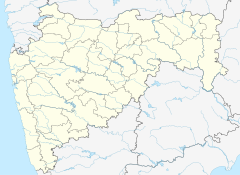
Summary
The Trivikrama Temple, also named Ter Temple, is a temple of Vamana (an incarnation of Vishnu) in Ter, Maharashtra. Henry Cousens, followed by most later writers, believed that it was originally a Buddhist temple, however in 1957 M. S. Mate disputed this view.[1]
| Trivikrama Temple | |
|---|---|
 Trivikrama Temple (front) | |
| Religion | |
| Affiliation | Hinduism |
| District | Osmanabad |
| Location | |
| Location | Ter, Maharashtra |
| State | Maharashtra |
| Country | |
 Location within Maharashtra  Trivikrama Temple (Maharashtra) | |
| Geographic coordinates | 18°19′10″N 76°8′30″E / 18.31944°N 76.14167°E |
The temple is original in that it was initially based on a free-standing apsidal structure, now located at the back of the building, which is characteristic of early Buddhist apsidal caityagriha designs.[2] The apsidal structure seems to be contemporary to the great apsidal temple found in Sirkap, Taxila, which is dated to 30 BCE-50 CE.[2] It would have been built under the Satavahanas, in the 2nd or 3rd century CE.[3]
The external flat-roofed mandapa structure is probably only an addition from the 6th century CE, when the temple was converted into a Hindu temple.[2] A stone image of Trivikrama probably dates to the early Chalukyas.[3]
The front of the apsidal temple is decorated with a chaitya-arch, similar to those found in Buddhist rock-cut architecture.[2]
Another known Hindu temple constructed in a Chaitya-style, is the Pallava period Kapoteswara temple at Chezarla in Guntur district. The legend behind the deity Kapoteswara is the story of Sibi in Mahabharata which also occurs in Sibi Jataka[4]
The Trivikrama Temple is considered as the oldest standing structure in Maharashtra.[3]
-
 Side view
Side view -
 View of the upper part of the temple
View of the upper part of the temple -
 Plan and elevation of the Trivikrama Temple.
Plan and elevation of the Trivikrama Temple. -
 Reconstitution of the original Buddhist apsidal temple.
Reconstitution of the original Buddhist apsidal temple. -
 The ancient Buddhist chaitya house at Ter.
The ancient Buddhist chaitya house at Ter.
See also edit
References edit
- ^ THE TRIVIKRAM TEMPLE AT TER, M. S. Mate, Bulletin of the Deccan College Post-Graduate and Research Institute, Vol. 18, TARAPOREWALA MEMORIAL VOLUME (January 1957), pp. 1-4
- ^ a b c d Le, Huu Phuoc (2010). Buddhist Architecture. Grafikol. p. 237. ISBN 9780984404308.
- ^ a b c Michell, George (2013). Southern India: A Guide to Monuments Sites & Museums. Roli Books Private Limited. p. 142. ISBN 9788174369031.
- ^ Ahir, D. C. (1992). Buddhism in South India. South Asia Books. p. 72. ISBN 9788170303329.







